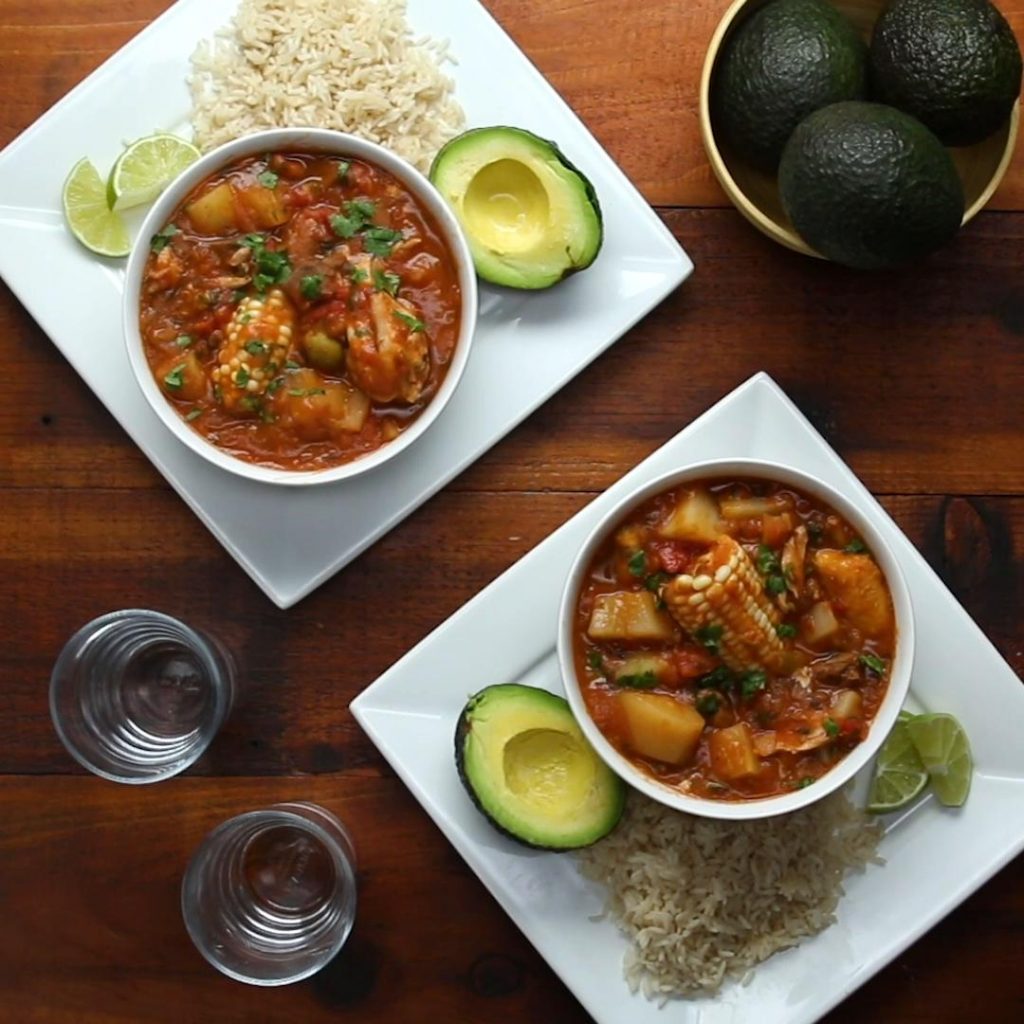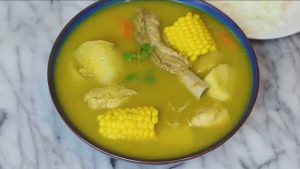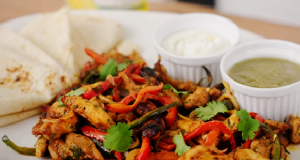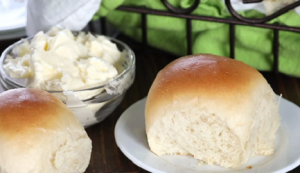Sancocho is a robust and hearty stew that hails from Puerto Rico. It's a one-pot dish brimming with delicious meats, root vegetables, and exotic flavors, sure to fill you up and leave you satisfied.

Some ingredients for Sancocho may not be commonly found in every kitchen, such as sofrito, recaito, and yucca. Sofrito and recaito are flavorful spice blends that form the base of many Latin dishes. Yucca is a root vegetable popular in Caribbean cuisine known for its starchy texture and mild flavor. These ingredients can usually be found in the international section of a well-stocked supermarket.
Essential Ingredients for Puerto Rican Sancocho
Olive oil: A base to sauté the vegetables and spices.
Yellow onion: Enhances the flavor profile of the stew.
Green pepper: Adds a subtle bitterness that complements the other flavors.
Cilantro: Adds a refreshing top note to the stew.
Garlic: Essential for the deep, savory flavor of the stew.
White cooking wine: Deglazes the pot and provides acidity.
Tomato: Adds sweetness and body to the stew.
Sofrito: A blend of herbs and spices that forms the base flavor.
Recaito: A mix of cilantro, garlic, onion, and peppers to enhance the taste.
Spanish green olive: Provides a briny contrast to the rich stew.
Ground cumin: A warm spice that adds depth to the stew.
Chuck roast: Provides hearty and tender meat.
Chicken broth: Adds a savory note and forms the base of the stew.
Chicken drumstick: Adds additional protein and flavor.
Corn: Adds a sweet contrast to the rich stew.
Russet potatoes: Thickens the stew and provides a starchy base.
Yucca: A root vegetable with a unique texture and flavor.
Plantains: Adds a sweet, tropical note to the stew.
Avocado: Serves as a creamy, fresh garnish.
White rice: A traditional side that soaks up the flavorful broth.
Lime wedge: Adds a refreshing acidity to each serving.
One reader, Aldis Valente says:





This Puerto Rican sancocho recipe is a game-changer! The flavors are rich and comforting, and the combination of meats and vegetables creates a hearty and satisfying dish. The aroma alone is enough to make your mouth water. It's a must-try for anyone who loves traditional, flavorful cuisine.
Techniques for Preparing Puerto Rican Sancocho
How to prepare the sofrito and recaito: Sofrito and recaito are essential flavor bases in Puerto Rican cuisine. To prepare sofrito, blend together green bell peppers, onions, garlic, cilantro, and ají dulce peppers. Recaito is made by blending cilantro, culantro, garlic, onion, and ají dulce peppers. These aromatic blends add depth and flavor to the sancocho.
How to select and prepare the yuca: When selecting yuca, choose roots that are firm with no soft spots. To prepare yuca, first peel the thick, waxy skin using a sharp knife. Then, cut the yuca into manageable pieces and remove the fibrous core running through the center. Afterward, the yuca can be chopped into smaller pieces for the sancocho.
How to cut the plantains: To prepare the plantains for the sancocho, peel the skin and cut them into thick slices or chunks. The plantains will add a subtle sweetness and heartiness to the dish.
How to serve the sancocho: When serving the sancocho, ladle the hearty soup into bowls and garnish with fresh cilantro. Serve alongside halved avocados, white rice, and lime wedges to complement the rich flavors of the dish.
How To Make Puerto Rican Sancocho
Get warm and comfy with a bowl of this sancocho loaded with chicken drumsticks, corn, and potatoes cooked in a flavorful broth.
Serves:
Ingredients
- 2tbspolive oil
- 1cupyellow onion,chopped
- 1cupgreen pepper,diced
- 1½cupsfresh cilantro,chopped, plus more for serving
- 5clovesgarlic,chopped
- ½cupwhite cooking wine
- 29oztomato,(2 cans), diced
- 15oztomato sauce,1 can
- 2tbspsofrito
- 2tbsprecaito
- 3tbspSpanish green olive
- 2tspground cumin
- salt,to taste
- pepper,to taste
- 1lbchuck roast,or stew beef
- 2cupschicken broth
- 4cupswater
- 1lbchicken drumstick
- 3ears corn,shucked, broken into large pieces
- 2russet potatoes,peeled and cubed
- 1yucca,peeled and cubed
- 2plantains,sliced into 2-in pieces
For Serving:
- avocado,halved
- white rice,cooked
- lime wedge
Instructions
-
Heat the olive oil in a large pot over medium heat.
-
Add the onion, green pepper, cilantro, and garlic. Cook for about 5 minutes until the onions are translucent.
-
Add the cooking wine, diced tomatoes, tomato sauce, sofrito, recaito, Spanish olives, cumin, salt, and pepper. Stir for 2 to 3 minutes to allow the flavors to meld.
-
Add the stew beef. Increase the heat to high and cook for 2 to 3 minutes, until the meat is cooked through. Add the chicken broth and water. Stir to combine.
-
Add the chicken, corn, potatoes, and yuca. Stir well. Cover and cook over medium-high heat for about 45 minutes, stirring occasionally, until the meat is tender and the potatoes are softened.
-
Reduce the heat to low and add the plantains. Simmer uncovered for 15 minutes, until the plantains are tender.
-
Garnish the soup with cilantro and serve with halved avocados, rice, and lime wedges, if desired.
-
Enjoy!
Nutrition
- Calories: 540.66kcal
- Fat: 14.92g
- Saturated Fat: 3.68g
- Trans Fat: 0.17g
- Monounsaturated Fat: 7.13g
- Polyunsaturated Fat: 2.46g
- Carbohydrates: 75.17g
- Fiber: 7.65g
- Sugar: 17.96g
- Protein: 30.86g
- Cholesterol: 90.25mg
- Sodium: 1721.04mg
- Calcium: 89.04mg
- Potassium: 1742.24mg
- Iron: 4.94mg
- Vitamin A: 109.42µg
- Vitamin C: 67.55mg
Technique Tip for Perfecting Sancocho
When adding the plantains to the sancocho, make sure they are ripe but still firm. Overripe plantains can become mushy and lose their shape in the stew. On the other hand, unripe plantains won't provide the sweet contrast that balances the savory flavors of the stew. Also, when peeling the plantains, run a knife along the seams of the skin, then peel it back. This method makes it easier to remove the skin without losing too much of the fruit.
Time-Saving Tips for Puerto Rican Sancocho
Prep ahead: Chop and prepare all your ingredients in advance to streamline the cooking process.
Use a pressure cooker: Consider using a pressure cooker to significantly reduce the cooking time for the meats and root vegetables.
Multi-task: While the sancocho is simmering, use that time to prepare the side dishes or clean up the kitchen to save time later.
Buy pre-cut: Purchase pre-cut yucca, plantains, and other root vegetables to save time on prep work.
Organize your workspace: Keep your cooking area organized and clean to avoid wasting time searching for utensils or ingredients.
Substitute Ingredients For Puerto Rican Sancocho Recipe
olive oil - Substitute with avocado oil: Avocado oil has a similar flavor profile to olive oil and can be used as a healthier alternative.
yellow onion - Substitute with white onion: White onions have a slightly milder flavor compared to yellow onions, but they can still provide a good base for the sancocho.
green pepper - Substitute with red bell pepper: Red bell peppers can be used as a substitute for green peppers, adding a slightly sweeter flavor to the dish.
fresh cilantro - Substitute with fresh parsley: Fresh parsley can be used as a substitute for cilantro, providing a similar fresh and herbaceous flavor to the sancocho.
garlic - Substitute with garlic powder: If fresh garlic is not available, garlic powder can be used as a substitute, although the flavor may be slightly different.
white cooking wine - Substitute with chicken or vegetable broth: Chicken or vegetable broth can be used as a substitute for white cooking wine to add depth of flavor to the sancocho.
tomato - Substitute with canned diced tomatoes: Canned diced tomatoes can be used as a substitute for fresh tomatoes, providing a convenient alternative.
tomato sauce - Substitute with crushed tomatoes: Crushed tomatoes can be used as a substitute for tomato sauce, adding a chunkier texture to the sancocho.
sofrito - Substitute with sazon seasoning: Sazon seasoning can be used as a substitute for sofrito, providing a similar flavor profile with added spices.
recaito - Substitute with cilantro and garlic paste: A mixture of cilantro and garlic paste can be used as a substitute for recaito, adding a similar flavor to the dish.
Spanish green olive - Substitute with pitted black olives: Pitted black olives can be used as a substitute for Spanish green olives, providing a different but complementary flavor to the sancocho.
ground cumin - Substitute with ground coriander: Ground coriander can be used as a substitute for cumin, providing a similar warm and earthy flavor to the dish.
chuck roast - Substitute with beef stew meat: Beef stew meat can be used as a substitute for chuck roast, providing a similar texture and flavor when cooked in the sancocho.
chicken broth - Substitute with vegetable broth: Vegetable broth can be used as a substitute for chicken broth, adding a different but complementary flavor to the sancocho.
chicken drumstick - Substitute with chicken thighs: Chicken thighs can be used as a substitute for chicken drumsticks, providing a different cut of meat with a similar flavor.
corn - Substitute with frozen corn: Frozen corn can be used as a substitute for fresh corn, providing a convenient alternative.
russet potatoes - Substitute with Yukon Gold potatoes: Yukon Gold potatoes can be used as a substitute for russet potatoes, providing a similar texture and flavor to the sancocho.
yucca - Substitute with potatoes: Potatoes can be used as a substitute for yucca, providing a starchy element to the dish.
plantains - Substitute with green bananas: Green bananas can be used as a substitute for plantains, providing a similar starchy component to the sancocho.
avocado - Substitute with sour cream: Sour cream can be used as a substitute for avocado as a topping for the sancocho, adding a creamy element to the dish.
white rice - Substitute with brown rice: Brown rice can be used as a substitute for white rice, providing a nuttier flavor and additional nutrients.
lime wedge - Substitute with lemon wedge: Lemon wedges can be used as a substitute for lime wedges, providing a similar citrusy flavor to the sancocho.
Presenting Puerto Rican Sancocho
Elevate the plating: When presenting the Puerto Rican sancocho, consider using a wide-rimmed bowl to showcase the vibrant colors and layers of the dish. The bowl should be deep enough to hold the hearty soup and its various ingredients, allowing the aromas to waft up and entice the senses.
Garnish with fresh cilantro: Sprinkle a generous amount of freshly chopped cilantro over the sancocho just before serving. The vibrant green color and aromatic fragrance of the cilantro will add a pop of freshness to the dish, enhancing its visual appeal and flavor profile.
Artfully arrange the avocado: Slice the avocado into thin, elegant wedges and delicately fan them out on top of the sancocho. The creamy texture and rich green hue of the avocado will provide a luxurious touch to the presentation, inviting diners to indulge in its velvety goodness.
Accent with a lime wedge: Place a small, intricately cut lime wedge on the rim of the bowl or delicately float it atop the sancocho. The bright citrusy notes of the lime will complement the robust flavors of the soup, adding a zesty and visually striking element to the presentation.
Serve with precision: Pay attention to the placement of each component in the bowl, ensuring that the meats, vegetables, and broth are harmoniously arranged to create an enticing visual composition. Precision in plating demonstrates care and attention to detail, elevating the overall dining experience.
Essential Tools for Making Sancocho
- Cutting board: A flat surface used for cutting and preparing ingredients.
- Chef's knife: A versatile knife used for chopping, slicing, and dicing a variety of ingredients.
- Stockpot: A large, deep pot used for making soups, stocks, and stews.
- Wooden spoon: A sturdy spoon made of wood, ideal for stirring and mixing ingredients in hot dishes.
- Blender: A kitchen appliance used to blend, puree, or emulsify food and other substances.
- Measuring cups and spoons: Essential tools for accurately measuring ingredients in cooking and baking.
- Tongs: A utensil with two arms and a pivot used for picking up and manipulating food.
- Ladle: A long-handled spoon with a deep bowl for serving soups, stews, and sauces.
- Potato peeler: A tool designed specifically for peeling the skin off potatoes and other vegetables.
- Dutch oven: A heavy-duty, thick-walled cooking pot with a tight-fitting lid, suitable for braising, stewing, and roasting.
Storing and Freezing Puerto Rican Sancocho
- Allow the sancocho to cool completely before storing or freezing.
- For storing in the refrigerator, transfer the cooled sancocho to an airtight container. It will keep well in the fridge for up to 4 days.
- When ready to reheat, place the desired portion in a saucepan over medium heat, stirring occasionally, until heated through. You may need to add a splash of chicken broth or water to thin out the consistency if it has thickened during storage.
- For freezing, transfer the cooled sancocho to freezer-safe containers or resealable bags, leaving about an inch of headspace to allow for expansion. Label the containers with the date and contents.
- Frozen sancocho will keep well for up to 3 months.
- To reheat from frozen, place the frozen sancocho in a saucepan and heat over medium-low heat, stirring occasionally, until it has thawed and heated through. You may need to add some additional chicken broth or water to achieve the desired consistency.
- Note: The potatoes, yuca, and plantains may become slightly softer in texture after freezing and reheating, but the overall flavor of the dish will remain delicious.
How To Reheat Leftover Sancocho
Reheat the sancocho in a large pot on the stove over medium heat, stirring occasionally until it reaches the desired temperature. This method allows the flavors to meld together even more, and the vegetables and meat will remain tender.
If you're short on time, you can reheat individual portions of the sancocho in the microwave. Place the desired amount in a microwave-safe bowl, cover with a damp paper towel, and heat in 30-second intervals, stirring in between, until heated through. Keep in mind that the texture of the vegetables and meat may change slightly when microwaved.
For a crispy twist, reheat the sancocho in a large, oven-safe skillet or Dutch oven. Preheat the oven to 350°F (175°C), place the skillet with the sancocho inside, and bake for 15-20 minutes, or until heated through and slightly crispy on top. This method works best if you have a considerable amount of leftover sancocho.
If you want to add some freshness to your reheated sancocho, garnish it with some freshly chopped cilantro, diced avocado, or a squeeze of lime juice just before serving. These additions will brighten up the flavors and make the soup taste like it was just made.
For a creamier reheated sancocho, stir in a dollop of sour cream or heavy cream before reheating. This will add a rich, velvety texture to the soup and help balance out the spices.
Interesting Fact About Puerto Rican Sancocho
Sancocho is a traditional stew in Puerto Rican cuisine, often served during special occasions and family gatherings. It is a hearty and flavorful dish that brings people together to enjoy a delicious meal.
Is Making Sancocho at Home Cost-Effective?
The cost-effectiveness of this Puerto Rican sancocho recipe largely depends on the availability and cost of ingredients in your area. The use of affordable staples like potatoes, corn, and chicken makes it relatively budget-friendly. However, the inclusion of beef and yucca may increase the overall cost. Considering the variety of ingredients and the potential for leftovers, this recipe could be rated a solid 8 for cost-effectiveness. The approximate cost for a household of 4 people is around $25-$30, making it a reasonable option for a hearty, flavorful meal.
Is Puerto Rican Sancocho Healthy or Unhealthy?
The Puerto Rican Sancocho recipe is a hearty and flavorful soup that incorporates a variety of ingredients. While it does contain some nutritious elements, there are aspects that could be improved to make it a healthier dish overall.
On the positive side, the recipe includes:
- Vegetables like onions, peppers, tomatoes, corn, and potatoes, which provide essential vitamins, minerals, and fiber
- Lean protein sources such as chicken drumsticks and chuck roast, which are important for muscle growth and repair
- Yucca and plantains, which are good sources of complex carbohydrates and dietary fiber
However, there are some potential drawbacks:
- The use of cooking wine and a significant amount of added salt may increase the sodium content of the dish
- The inclusion of olive oil and potentially fatty cuts of meat could contribute to a higher saturated fat content
- The recipe lacks leafy greens or other non-starchy vegetables that could provide additional nutrients and balance
To enhance the nutritional value of this Puerto Rican Sancocho, consider the following modifications:
- Reduce the amount of added salt and opt for low-sodium chicken broth to control the overall sodium content
- Choose leaner cuts of beef, such as sirloin or tenderloin, to minimize saturated fat intake
- Incorporate more non-starchy vegetables like carrots, celery, or leafy greens to boost the fiber and nutrient density of the soup
- Use a smaller amount of olive oil or replace it with a healthier alternative, such as avocado oil or coconut oil
- Serve the soup with a side salad or additional steamed vegetables to increase the overall vegetable intake per serving
By making these adjustments, you can transform this traditional Puerto Rican Sancocho into a more well-rounded and nutritious meal that still retains its delicious flavors and comforting qualities.
Editor's Opinion on This Sancocho Recipe
The Puerto Rican sancocho recipe is a delightful blend of flavors and textures, creating a hearty and comforting dish. The combination of meats, vegetables, and aromatic herbs and spices results in a rich and satisfying soup. The use of sofrito, recaito, and Spanish olives adds depth and complexity to the dish, while the addition of plantains and yucca brings a unique and delightful twist. The finished dish is a true celebration of Puerto Rican cuisine, perfect for bringing friends and family together around the dinner table.
Enhance Your Puerto Rican Sancocho Recipe with These Unique Side Dishes:
Similar Recipes to Puerto Rican Sancocho
Appetizer and Dessert Pairings for Sancocho
Why trust this Puerto Rican Sancocho Recipe:
This recipe is a true taste of Puerto Rican cuisine, carefully crafted with authentic ingredients like sofrito, recaito, and Spanish green olives. The combination of stew beef and chicken creates a rich and hearty flavor, while the addition of yucca, plantains, and corn adds a delightful depth to the dish. The use of fresh cilantro and garlic enhances the aromatic profile, ensuring a truly satisfying experience. Trust in the traditional elements and meticulous preparation of this sancocho recipe for an unforgettable culinary journey.
Was this page helpful?
Have your own special recipe to share? Submit Your Recipe Today!













